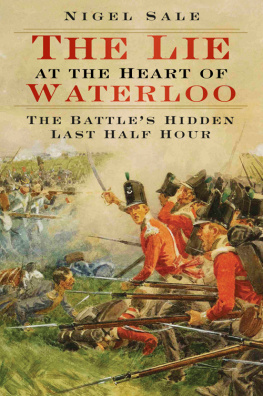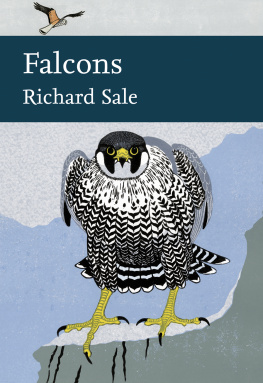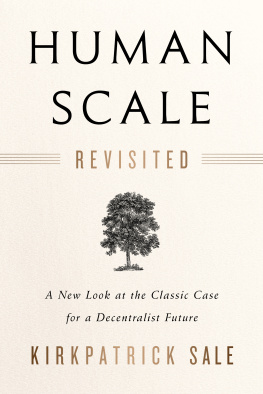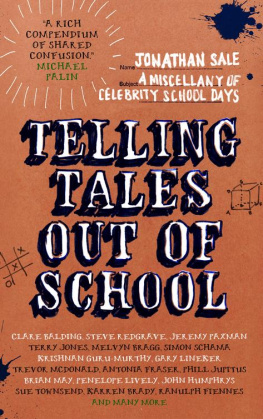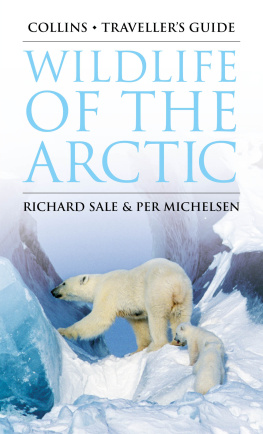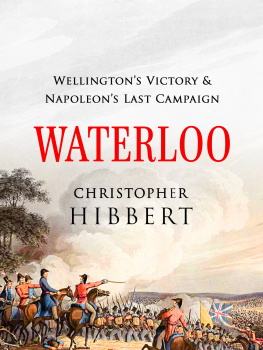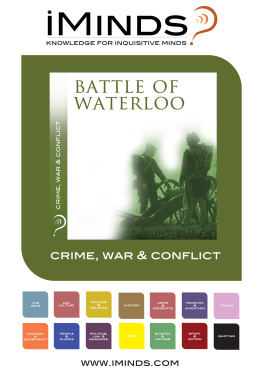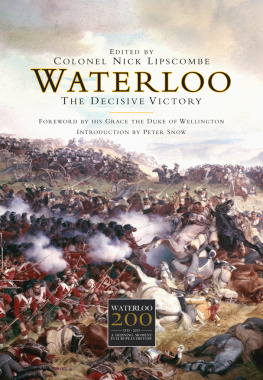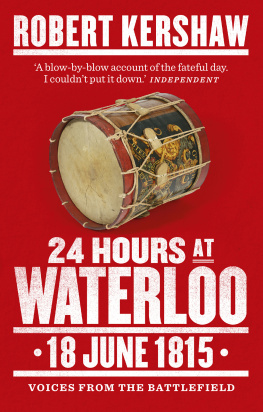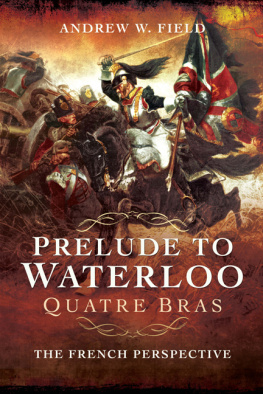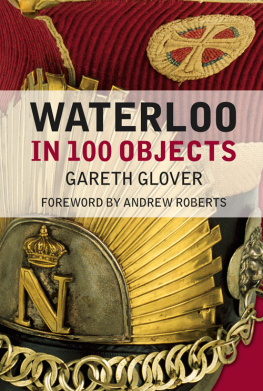
To the memory of Robert Osborne
Front cover : Charge of the 52nd under Sir John Colborne at 8pm by William Barnes Wollen 18571936 (Courtesy of the Royal Green Jackets (The Rifles) Museum, Winchester)
*The artist has erred in illustrating the men wearing the Belgic shako, with a flange at the front, instead of the old stovepipe which is sported by the officer.
Although the embers of determining exactly what happened at the end of the battle had smouldered in my mind for decades, they were fanned into life in the early twenty hundreds by the enthusiasm of retired Colonel David Stanley, when we toured some of the battlefields in Belgium and Normandy in which our regiment had been involved. The resulting fire has kept me warm for many years and provided many eureka moments.
I am indebted to two helpers with my research. On the one hand, John Franklin of 1815 Ltd has been generous with his provision, both online and in book form, not only of newly published material, particularly from Hanoverian and Netherlands sources, but also of British accounts, to add to the mass that has been in the public domain for over one and a half centuries. On the other hand, retired Colonel Robert Osborne, a long-standing army friend, was a tower of strength both in seeking material from otherwise inaccessible academic resources and in acting as a very well informed sounding board for ideas. His death in 2009 was an immeasurable loss.
I am indebted to Leonard Bentley for the intriguing information about the 1st Guards nickname mentioned in the epilogue, gleaned in the process of his transcribing handwritten Metropolitan Police Orders for historical purposes. My thanks go, too, to Christine Pullen of the Royal Green Jackets Museum for her help with images and to Cressida Downing, book analyst, for the controversial title.
I am very grateful to two readers of successive drafts retired Lieutenant Colonel Ewan Sale, Royal Marines, and Mrs Judy Goodland, not a retired colonel but ex-headmistress of a well-known girls public school and therefore of the same sterling quality both nobly read and commented upon my early manuscripts. The final reader was history Professor Ian Beckett to whom I shall be eternally grateful for valuable advice and support.
It would be amiss of me not to pay tribute to the patience exhibited by Shaun Barrington, of The History Press, in guiding me through the painful process of publication with exemplary patience.
C ONTENTS
It is no longer fashionable to write of decisive battle, as did Sir Edward Creasy in 1851. Creasys Fifteen Decisive Battles of the World, ranging from Marathon to Waterloo, were engagements that had changed the course of history for the better. Thus, for Creasy, such admirable traits as Greek wisdom, Roman virtue, European Protestantism, and English liberty had all been preserved for posterity by battle. Yet, there is no denying that, from the moment the guns fell silent, its contemporaries regarded Waterloo as a pivotal moment in history. Where once that implied the battles military and political significance, it was increasingly seen as equally important in terms of its social and cultural legacies. Waterloo loomed large in art, literature, and popular memory. Not surprisingly, it has generated a vast literature, and has raised enduring historical controversies, not least how the Duke of Wellington chose to represent his victory.
The long accepted version, deriving from Wellingtons own Waterloo Despatch, has been that, at the climax of the battle, the British Guards routed Napoleons Imperial Guard to ensure victory. Wellington himself had chosen the decisive moment, his stirring Up Guards and at em becoming one of the most celebrated phrases in British military history. But there were other versions, which detracted from his reputation, that Wellington found it convenient to suppress. As the veteran of the Peninsular War and renowned military historian, William Napier, once wrote, there was a secret politics of Waterloo. The contribution of the Prussians to the victory was one such uncomfortable factor to be discounted. But so, too, was the role of the 52nd Foot in delivering a flanking attack that destroyed the left wing of the Imperial Guards advance. As Nigel Sale shows, the 52nd shattered the major and final French assault, and harried the remainder from the field.
It may be thought that there is little new to say about Waterloo on the approach of its bicentennial year. By focussing on the critical last stage of the battle, and the role of the 52nd Foot, however, Nigel Sale presents a persuasive case that offers a major re-interpretation of the existing historiography. The confusion of accounts as to the formation taken up by the Imperial Guard, the direction of its advance, and its precise composition as its elements encountered the British 1st Guards Brigade and the 52nd, is all expertly dissected. Based on an exhaustive study of the contemporary and near-contemporary evidence, the ground, and the military probabilities, Nigel Sale radically recasts the sequence of events in the late afternoon and evening of 18 June 1815. It is also a story of how the officers of the 52nd who knew the truth, such as John Colborne, William Leeke, and George Gawler, saw their contribution to victory, and that of their men, ignored by Wellington and forgotten by history. In this, too, Nigel Sale adds materially to the story of Wellingtons many historical deceptions. The Prussian contribution to Waterloo is now widely recognised. In the light of Nigel Sales outstanding historical detective work, the 52nd deserves no less.
Professor Ian F. W. Beckett,
Professor of Military History,
University of Kent.
The Duke led on a brigade consisting of the 52nd and 95th Regt s; An etching from John Booths compendium Waterloo etc (Tenth edition, 1817. 1st edition 1816)
Emperor Napoleon in 1806 ; Oil on canvas by douard Detaille
Generalfeldmarschall Prince Gebhard Leberecht von Blcher , 1864. Artist unknown
Map 1. The campaign opens
Field Marshal Arthur Wellesley, 1st Duke of Wellington; Engraving by W. Say after Thomas Phillips. 1909
The Morning of Waterloo , Detail from a painting by J.D. Aylward (Courtesy of the Royal Green Jackets (The Rifles) Museum)
Map 3 . The Prussian Advance
Lieutenant-General Sir Thomas Picton ; Detail from a soft-ground etching by William Daniell after George Dance. 1809 ( National Portrait Gallery, London)
Marchal Michel Ney ; Oil by Francois Grard. 1805
Major-General Sir Colin Halkett ; Detail from an oil on canvas by William Salter, c .1838 ( National Portrait Gallery, London)
Lieutenant-Colonel William Elphinstone ; Detail from an oil on canvas by William Salter, 1836-1839 ( National Portrait Gallery London)
Up Guards and at them ; An etching from John Booths compendium Waterloo etc.; Tenth edition, 1817. First edition published 20 Dec 1816
Major-General Sir Peregrine Maitland ; Detail from an oil on canvas by William Salter, 1834-1840 ( National Portrait Gallery, London)
Captain and Lieutenant-Colonel Alexander Fraser , the 16th Lord Saltoun, Detail from an oil on canvas by William Salter, c. 1837 ( National Portrait Gallery, London)
The Tongu e; Detail from a map published by J. Booth, London, 1816
Colonel Sir John Colborne ; Jan Willem Pieneman ( English Heritage)
Next page
